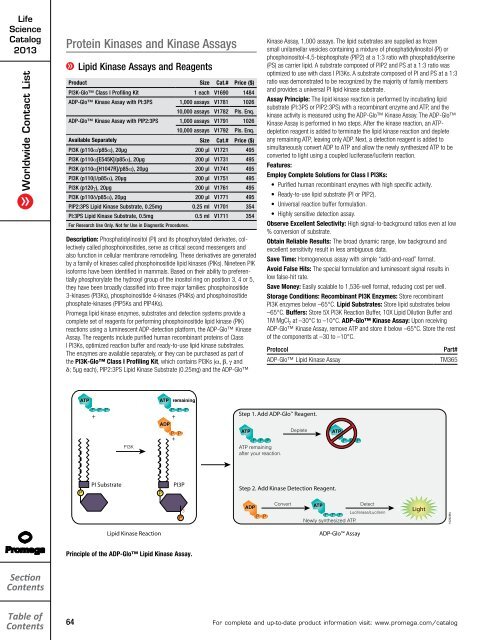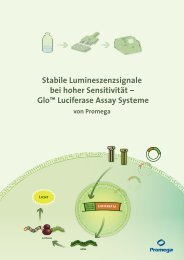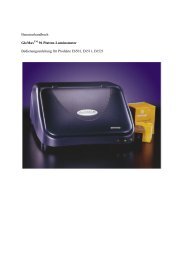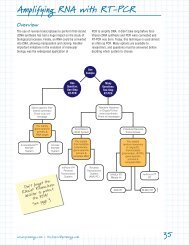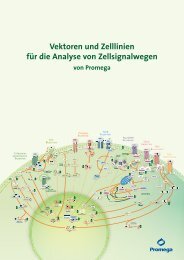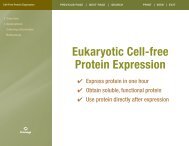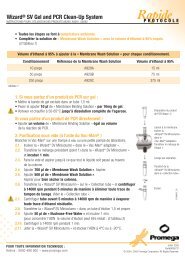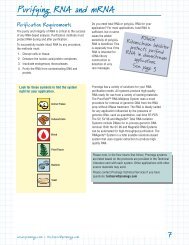2013 Promega catalogue
2013 Promega catalogue
2013 Promega catalogue
Create successful ePaper yourself
Turn your PDF publications into a flip-book with our unique Google optimized e-Paper software.
Life<br />
Science<br />
Catalog<br />
<strong>2013</strong><br />
Worldwide Contact List<br />
Cell Signaling<br />
Protein Kinases and Kinase Assays<br />
Lipid Kinase Assays and Reagents<br />
Product Size Cat.# Price ($)<br />
PI3K-Glo Class I Profiling Kit 1 each V1690 1484<br />
ADP-Glo Kinase Assay with PI:3PS 1,000 assays V1781 1026<br />
10,000 assays V1782 Pls. Enq.<br />
ADP-Glo Kinase Assay with PIP2:3PS 1,000 assays V1791 1026<br />
10,000 assays V1792 Pls. Enq.<br />
Available Separately Size Cat.# Price ($)<br />
PI3K (p110α/p85α), 20µg 200 μl V1721 495<br />
PI3K (p110α[E545K]/p85α), 20µg 200 μl V1731 495<br />
PI3K (p110α[H1047R]/p85α), 20µg 200 μl V1741 495<br />
PI3K (p110β/p85α), 20µg 200 μl V1751 495<br />
PI3K (p120γ), 20µg 200 μl V1761 495<br />
PI3K (p110δ/p85α), 20µg 200 μl V1771 495<br />
PIP2:3PS Lipid Kinase Substrate, 0.25mg 0.25 ml V1701 354<br />
PI:3PS Lipid Kinase Substrate, 0.5mg 0.5 ml V1711 354<br />
For Research Use Only. Not for Use in Diagnostic Procedures.<br />
Description: Phosphatidylinositol (PI) and its phosphorylated derivates, collectively<br />
called phosphoinositides, serve as critical second messengers and<br />
also function in cellular membrane remodeling. These derivatives are generated<br />
by a family of kinases called phosphoinositide lipid kinases (PIKs). Nineteen PIK<br />
isoforms have been identified in mammals. Based on their ability to preferentially<br />
phosphorylate the hydroxyl group of the inositol ring on position 3, 4 or 5,<br />
they have been broadly classified into three major families: phosphoinositide<br />
3-kinases (PI3Ks), phosphoinositide 4-kinases (PI4Ks) and phosphoinositide<br />
phosphate-kinases (PIP5Ks and PIP4Ks).<br />
<strong>Promega</strong> lipid kinase enzymes, substrates and detection systems provide a<br />
complete set of reagents for performing phosphoinositide lipid kinase (PIK)<br />
reactions using a luminescent ADP-detection platform, the ADP-Glo Kinase<br />
Assay. The reagents include purified human recombinant proteins of Class<br />
I PI3Ks, optimized reaction buffer and ready-to-use lipid kinase substrates.<br />
The enzymes are available separately, or they can be purchased as part of<br />
the PI3K-Glo Class I Profiling Kit, which contains PI3Ks (α, β, γ and<br />
δ; 5μg each), PIP2:3PS Lipid Kinase Substrate (0.25mg) and the ADP-Glo<br />
Kinase Assay, 1,000 assays. The lipid substrates are supplied as frozen<br />
small unilamellar vesicles containing a mixture of phosphatidylinositol (PI) or<br />
phosphoinositol-4,5-bisphosphate (PIP2) at a 1:3 ratio with phosphatidylserine<br />
(PS) as carrier lipid. A substrate composed of PIP2 and PS at a 1:3 ratio was<br />
optimized to use with class I PI3Ks. A substrate composed of PI and PS at a 1:3<br />
ratio was demonstrated to be recognized by the majority of family members<br />
and provides a universal PI lipid kinase substrate.<br />
Assay Principle: The lipid kinase reaction is performed by incubating lipid<br />
substrate (PI:3PS or PIP2:3PS) with a recombinant enzyme and ATP, and the<br />
kinase activity is measured using the ADP-Glo Kinase Assay. The ADP-Glo<br />
Kinase Assay is performed in two steps. After the kinase reaction, an ATPdepletion<br />
reagent is added to terminate the lipid kinase reaction and deplete<br />
any remaining ATP, leaving only ADP. Next, a detection reagent is added to<br />
simultaneously convert ADP to ATP and allow the newly synthesized ATP to be<br />
converted to light using a coupled luciferase/luciferin reaction.<br />
Features:<br />
Employ Complete Solutions for Class I PI3Ks:<br />
• Purified human recombinant enzymes with high specific activity.<br />
• Ready-to-use lipid substrate (PI or PIP2).<br />
• Universal reaction buffer formulation.<br />
• Highly sensitive detection assay.<br />
Observe Excellent Selectivity: High signal-to-background ratios even at low<br />
% conversion of substrate.<br />
Obtain Reliable Results: The broad dynamic range, low background and<br />
excellent sensitivity result in less ambiguous data.<br />
Save Time: Homogeneous assay with simple “add-and-read” format.<br />
Avoid False Hits: The special formulation and luminescent signal results in<br />
low false-hit rate.<br />
Save Money: Easily scalable to 1,536-well format, reducing cost per well.<br />
Storage Conditions: Recombinant PI3K Enzymes: Store recombinant<br />
PI3K enzymes below –65°C. Lipid Substrates: Store lipid substrates below<br />
–65°C. Buffers: Store 5X PI3K Reaction Buffer, 10X Lipid Dilution Buffer and<br />
1M MgCl 2 at –30°C to –10°C. ADP-Glo Kinase Assay: Upon receiving<br />
ADP-Glo Kinase Assay, remove ATP and store it below –65°C. Store the rest<br />
of the components at –30 to –10°C.<br />
Protocol<br />
ADP-Glo Lipid Kinase Assay<br />
Part#<br />
TM365<br />
ATP<br />
ATP remaining<br />
P P P<br />
P P P<br />
+ +<br />
ADP<br />
P P<br />
+<br />
PI3K<br />
Step 1. Add ADP-Glo Reagent.<br />
ATP<br />
P P P<br />
ATP remaining<br />
after your reaction.<br />
Deplete<br />
ATP r<br />
P P P<br />
P<br />
PI Substrate<br />
P<br />
PI3P<br />
Step 2. Add Kinase Detection Reagent.<br />
3<br />
P<br />
ADP<br />
P<br />
P<br />
Convert<br />
ATP<br />
Detect<br />
Luciferase/Luciferin<br />
P P P<br />
Newly synthesized ATP.<br />
Light<br />
10262MA<br />
Lipid Kinase Reaction<br />
ADP-Glo Assay<br />
Principle of the ADP-Glo Lipid Kinase Assay.<br />
Section<br />
Contents<br />
Table of<br />
Contents<br />
64<br />
For complete and up-to-date product information visit: www.promega.com/catalog


